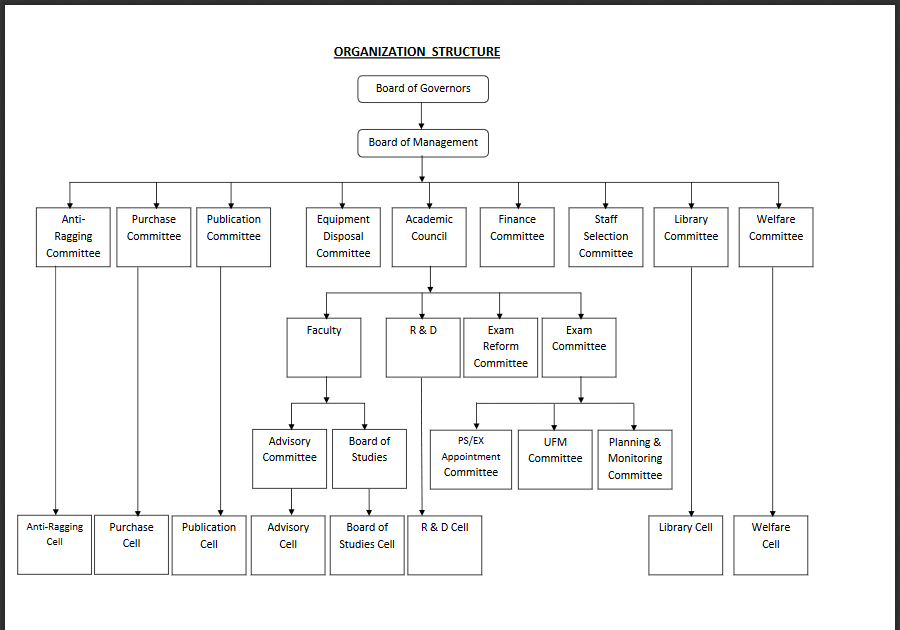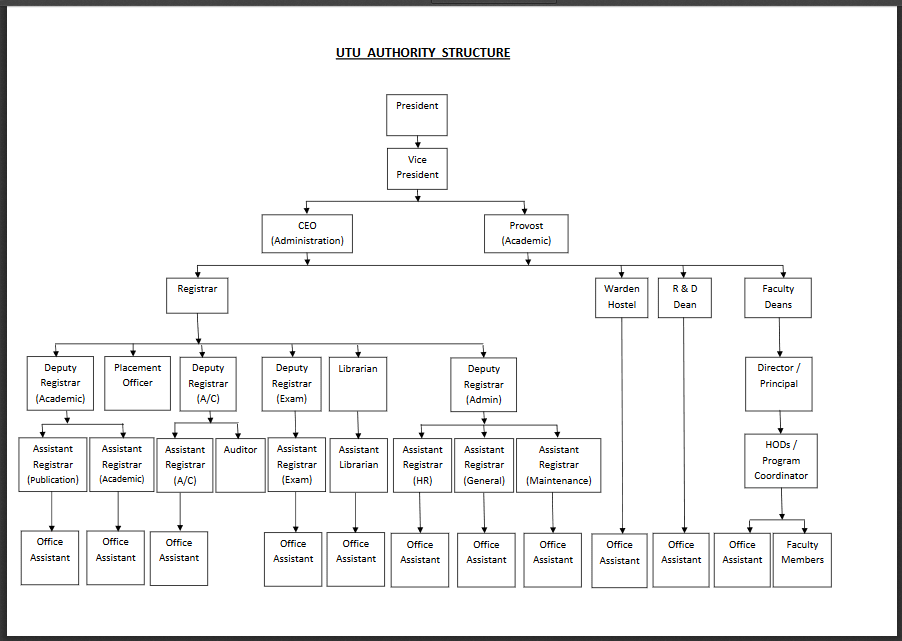Structure
-
1)The UKA Tarsadia University (UTU) is a non-affiliating, multi-campus university that fosters excellence in all its programmes and activities. Two important conditions fulfilled to meet this requirement is presented below.
- Academic autonomy to the constituent institutions to enable them to engage meaningfully in knowledge creation, development and dissemination in a comparatively conducive environment;
- Distribution of decision making influence on a wide basis and avoiding concentration of authority in a few persons or bodies, so that the academic environment is conducive to excellence in teaching, training, research, consulting and extension.
-
2)Keeping the above in view, the University has a three tier set up consisting of the following layers:
- Central Office of the University based at Gopal Vidhyanagar, with responsibility for enunciating policies and guidelines for setting up and operating campuses, programmes and activities;
- Campus management at the level of the individual campuses under the direction of the concerned campus executives; and
- Management of individual institutions within every campus under the direction and control of the concerned Principals.
- 3)The University's Board of Governors act as the apex body for taking all policy and strategic decisions, such as setting up new campuses, approval of new courses of study, collaboration with industries and other organisations and mobilisation of resources on long term basis. The Board of Governors consist of 11 members, of whom six nominees are from the Mandal, including the President and Secretary of the Mandal.
- 4)The University is headed by a President. The President of the University is the Chairman of the Board of Governors and of the annual convocation of the University. The President is assisted by Vice-President who is one of the six nominees of the Mandal. The Vice-President will be more actively involved in advising the Board of Governors on the strategic orientation of the University.
- 5)The Board of Governors have appointed a full time Director to function as the Chief Executive and Academic Officer of the University. He shall report to the Board of Governors and shall function under its superintendence, direction and control. The Director, in turn, is assisted by a Joint Director to take care of certain functions that will be delegated to him.
- 6)The Registrar of the University, who is the Secretary of the Board of Governors, looks after the non-academic support functions required to be provided for the academic institutions and other units to achieve excellence.
-
7)The project has three committees at the University level to advise and guide the Board of Governors for taking appropriate and meaningful decisions. They are as follows:
- Development Council, chaired by the Vice President of University to examine and develop plans for setting up new campuses and programmes of teaching, training, research, consulting, development and extension, and courses of study to meet the continuously changing needs of industry, trade, business, Government, and Non-Governmental organisations.
- Academic Council, chaired by the Director of the University to manage the standards of various programmes and activities of the University and to evolve recommendations in this regard for the consideration of the Board of Governors.
- Finance Committee, chaired by the Director of the University, to review the financial matters of the University and to make appropriate recommendations to the Board of Governors for consideration.
- 8)The second tier of management of the University, namely the individual campuses, is headed by the Campus Executive. For maintaining the highest standards of academic excellence, the position is senior to the Joint Director of the University. The Campus Executive is a member of the Development Council, Academic Council and Finance Committee. The Campus Director has adequate autonomy to set up Camps level Committees to advise him on the best way of managing the institutions within the Campus and achieve their goals. This is consistent with the Act of the University and its Regulations.
- 9)Every Campus, including the Campus at Gopal Vidhyanagar and Bardoli which is the nucleolus of the University is having a set up of institutions like MPC, CGBIBT, SRIMCA, MBNC, BVPIBMCIT, SRSS, CGPIT, PGSC nad PRBA&PGRC, each of this is headed by a Principal who is the academic and administrative authority of the institutions, accountable to the Campus Director. The Principals of the individual institutions have the necessary autonomy and flexibility to constitute suitable standing and adhoc committees for wider participation of the employees of the institution and to advise him on the various measures he should adopt for realising the goals of the institution and of the University. The role of the superstructure of the University, consisting of the Campus Administration and University Administration, is to facilitate the individual institutions to excel synergistically.
- 10)The reporting relationships and authority, functions and accountability of the various executives of a multi-campus set up like UTU, as outlined above, is elaborated further in the regulations of the University. However, the structure and dynamics of the organisations will be continuously evolving to keep pace with the changing conditions of the markets. A purely hierarchical line relationship, typical of a bureaucratic or military organisation, found in public universities, cannot be consistent with the requirement of flexibility for achieving academic excellence. At the same time, a loose arrangement may throw out symptoms of lack of purpose and control, accompanied by indiscipline and frustration. On the other hand, a dynamic and goal oriented private University is best modelled on the lines of a well managed corporate entity, which continuously reshapes itself to achieve the goals. UTU, being a Private University has adopted appropriate corporate models at different points of time. The choice and decision of a suitable model is ultimately the responsibility of the Board of Governors or the recommendations of the Councils or Committees which may be set up for such purposes.
Organisational StructurePDF

Authority StructurePDF

